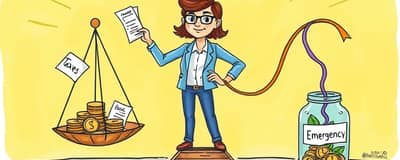How to Financially Prepare for Retirement: Practical Tips

Retirement planning is more than just setting aside a portion of each paycheck; it’s about constructing a comprehensive strategy that supports your desired lifestyle for two or more decades after you leave the workforce. With a growing life expectancy and rising living costs, taking control of your financial future is the greatest gift you can give yourself.
Only about half of Americans have calculated how much they need to save for retirement, and over a quarter of eligible private industry workers do not participate in defined contribution plans. By following a structured approach that combines disciplined saving, smart investing, and proactive planning, you can build a secure foundation for your golden years.
Start Saving Early and Stay Consistent
One of the most important principles in retirement planning is harnessing the power of compounding. By choosing to start saving as soon as possible, even modest contributions can grow significantly over time. A $200 monthly investment in a retirement account starting at age 25 can outperform a $500 monthly investment begun at age 35 simply due to the longer growth period.
Automate your savings so contributions occur each pay period without conscious effort. As your career progresses, increase contributions to match raises or bonuses. This habit not only accelerates wealth accumulation but also makes saving feel effortless rather than burdensome.
Calculate Your Retirement Needs
Estimating how much you will need in retirement is the cornerstone of a workable plan. Experts recommend targeting 70%–90% of your pre-retirement income annually. If you earn $80,000 per year today, aim for $56,000–$72,000 per year in retirement.
Factor in inflation, projected healthcare costs, and lifestyle choices. Will you downsize your home? Do you anticipate significant travel? By building a line-item budget for essential, discretionary, and unexpected expenses, you can refine your savings goal and confidently adjust your strategy over time.
Maximize Employer Retirement Plans
If you have access to a 401(k) or similar plan through your employer, missing out on contributions is like leaving free money unclaimed. Aim to contribute at least enough to receive the full employer match; this is a guaranteed return on your investment.
Understand your plan’s vesting schedule: some employer contributions may require you to stay with the company for several years before they fully belong to you. Enable automatic contribution increases to boost your savings rate gradually without feeling the pinch.
- Contribute up to the employer match threshold promptly.
- Check vesting periods to protect matching funds.
- Use automatic escalation features when available.
Diversify Investments and Rebalance
An effective portfolio balances growth potential with risk management. Early in your career, a heavier equity weighting can drive growth. As retirement approaches, shift toward bonds and cash equivalents to preserve capital and reduce volatility.
Regular rebalancing restores your target asset allocation by selling high-performing assets and buying underweighted ones. This disciplined approach enforces buy low, sell high behavior and prevents one asset class from overwhelming your portfolio.
Leverage Retirement Accounts and Catch-Up Contributions
In addition to 401(k)s, individual retirement accounts like IRAs and Roth IRAs offer valuable tax benefits. A Traditional IRA may reduce taxable income today, while a Roth IRA provides tax-free withdrawals in retirement.
Those aged 50 and older can make catch-up contributions for those over fifty, pushing annual contributions beyond standard limits and accelerating progress toward your goals.
- Traditional IRA: tax-deductible contributions.
- Roth IRA: tax-free growth and withdrawals.
- Health Savings Account: triple tax advantage for health costs.
Craft a Post-Retirement Budget and Vision
Retirement is as much a lifestyle transition as a financial one. Picture your ideal days: volunteer work, travel adventures, or quality time with family. This vision aids in estimating costs and prioritizing savings.
Create a detailed budget that breaks expenses into essentials (housing, utilities), leisure (travel, hobbies), and contingencies (emergencies, inflation). Identify current discretionary spending you can reduce to funnel more savings into retirement accounts.
Plan for Healthcare and Insurance
Healthcare costs typically rise as we age. Medicare covers basic expenses, but premiums, deductibles, and long-term care can create significant gaps. Investigate supplemental insurance policies and explore long-term care coverage options early to lock in lower premiums.
An HSA, if available, provides tax-deductible contributions, tax-free growth, and tax-free withdrawals for qualified medical expenses—making it a powerful tool for healthcare planning.
Social Security and Pension Strategies
Social Security can be claimed as early as age 62, but waiting until your full retirement age or later increases your benefit. Delaying benefits until age 70 can boost your monthly payment by nearly 24% compared to age 66.
Review pension options or annuity offers carefully. Spousal benefits and survivor provisions can ensure financial security for your partner, so confirm details before selecting payout options.
Withdrawal Strategies for Retirement Income
To make your savings last, you need a withdrawal strategy that balances income needs with market cycles. The classic 4% rule suggests withdrawing 4% of your portfolio in year one, then adjusting for inflation.
Market-sensitive approaches adjust withdrawals based on performance, preserving capital in down markets and allowing for higher distributions during upswings. Income-focused strategies, such as dividend-paying stocks or immediate annuities, can offer predictable cash flow.
Use Tools and Seek Professional Advice
Online retirement calculators help estimate how much you need to save by factoring in your desired retirement age, life expectancy, inflation, and expected returns. They provide a dynamic way to visualize different scenarios and adjust contributions.
When your financial picture becomes complex—multiple income sources, tax implications, estate planning—consult a certified financial planner (CFP) or tax professional. Personalized guidance can optimize strategies tailored to your unique situation.
Review and Adjust Regularly
Life rarely follows a straight line. Career shifts, market swings, family events, and health changes all influence your retirement readiness. Schedule annual check-ins to regularly review and update your plan, ensuring each component remains aligned with your long-term vision.
By embracing a disciplined approach—saving early, investing wisely, and planning meticulously—you can transform uncertainty into confidence and enjoy the retirement you deserve with financial freedom and peace of mind.
References
- https://legacy.trincoll.edu/retirement
- https://www.merrilledge.com/article/7-steps-prepare-for-your-upcoming-retirement
- https://www.ameriprise.com/financial-goals-priorities/retirement/7-top-retirement-tips
- https://www.schwab.com/learn/story/6-things-to-do-if-youre-nearing-retirement
- https://www.fidelity.com/learning-center/personal-finance/retirement/retirement-income-strategies
- https://www.ncoa.org/article/14-steps-to-get-ready-for-retirement/
- https://www.dol.gov/agencies/ebsa/workers-and-families/preparing-for-retirement






